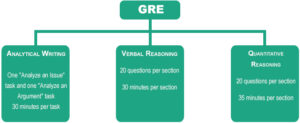Having an advanced degree on your resume can widen your opportunities. In line with it, the recent data from the Bureau of Labour Statistics and The Organisation for Economic Co-operation and Development depicts education’s role in increased earnings and low unemployment rates. Regardless of where you are going, be it a graduate school consisting of business or law, or simply just exploring different options, you are working towards making a necessary and unavoidable step for your future. Do we know what is GRE and its scoring system (The GRE score board)?
Well, let’s find out!
Register yourself for a free GRE demo class!
So, What is GRE?

What is GRE?
GRE, short form of Graduate Record Examination is owned and monitored by Education Testing services whose headquarters is recited in Princeton, New Jersey. Choosing GRE general test or the GRE subject test all depends on the course that the person is going to undertake or what the specific admission team requires from the student. However, the focus is on the GRE general test, considering the importance and popularity amongst the universities and the test candidates.
The GRE General Test is a computer based test that showcases the kind of thinking the candidate does through questions, the skills required to succeed in today’s day and age. The test taker permits you to skip questions within a section, go back and forth to change answers and nevertheless have the flexibility to jump between questions by choosing what to answer first. It helps you measure your verbal reasoning, quantitative reasoning, and analytical writing skills. These are the skills that have been built over a long period of time unrelated to any specific field of study but however necessary for all.
Do they follow a specific format?

follow a specific format
Total time of 3 hours 45 minutes, the test includes of 2 verbal sections, 2 quant sections and 1 Analytical writing section. Moreover, an additional Verbal or a Quant part which is either not a scoring experimental section or non-marked research question.
Order wise, Analytical writing comes first, followed by either verbal or quant in an unknown and random order. So thus, you can either have 1 verbal and then 1 quant or 2 verbal sections at the same time followed by 2 quant questions.
Finally, The GRE score board!!

The GRE score board
With a clear picture of what GRE is and its format, lets lastly dig into and understand The GRE score board.
The candidates are scored on three aspects:
- A Verbal Reasoning score is marked on a 130–170 score scale, in 1-point increments.
- A Quantitative Reasoning score is marked on a 130–170 score scale, in 1-point increments.
- An Analytical Writing score is marked on a 0–6 score level, in half-point increments.
Verbal and Quantitative Reasoning section:
The Verbal Reasoning and Quantitative Reasoning sections of the GRE general test are section-level adaptive. This depicts that the computer chooses the second section of a measure performance based on the first section. Amongst all the sections, all questions hold equal weight towards the final score. Before the final score, a raw score is compiled for both the measures. Note: The raw score is the correct answer given for each question.
The raw score is transformed to a scaled score through a procedure well known as equating. The equating procedure accounts for small changes in difficulty between the various test editions along with differences in difficulty between individuals’ tests initiated by the section-level adaptation. Hence, a given scaled score of a specific measure mirrors a similar degree of execution paying little mind to which segment was chosen and when the test was taken.
Analytical Reasoning section:
Every essay gets marked by at least one trained rater, keeping in mind a six-point holistic scale. In comprehensive scoring, raters are prepared to give scores based on the general and the overall nature of the essay. The paper score is then scored by e-rater®, an automated program created by ETS that is fit for distinguishing article highlights identified with composing capability. If for say the scores of both the humans and the e-rater match or are close enough, the average of both the scores in considered as the final score. But however, if thy deviate a subsequent human score is gotten, and the final score is the average of the two human scores.
The final scores on the two articles are then arrived at the midpoint of and adjusted to the closest half-point stretch on the 0–6 score scale. The individual score is accounted for the Analytical Writing measure. The primary focus in scoring the Analytical Writing section is on your basic reasoning and analytical writing skills instead of grammar and mechanics.
Finally, after comprehending The GRE score board, has the article helped you in gaining a deeper insight about the scoring system pattern? If you have any doubts or suggestions, leave a comment in the comment section down below!
Know the most common GRE Vocabulary words, ranging from least difficult to most difficult.

Recent Comments